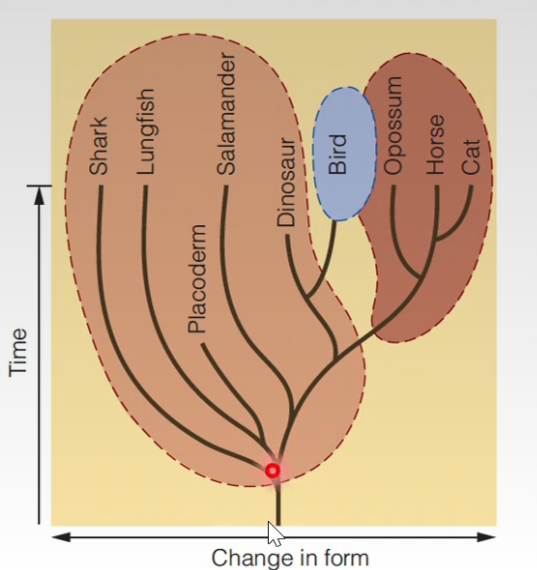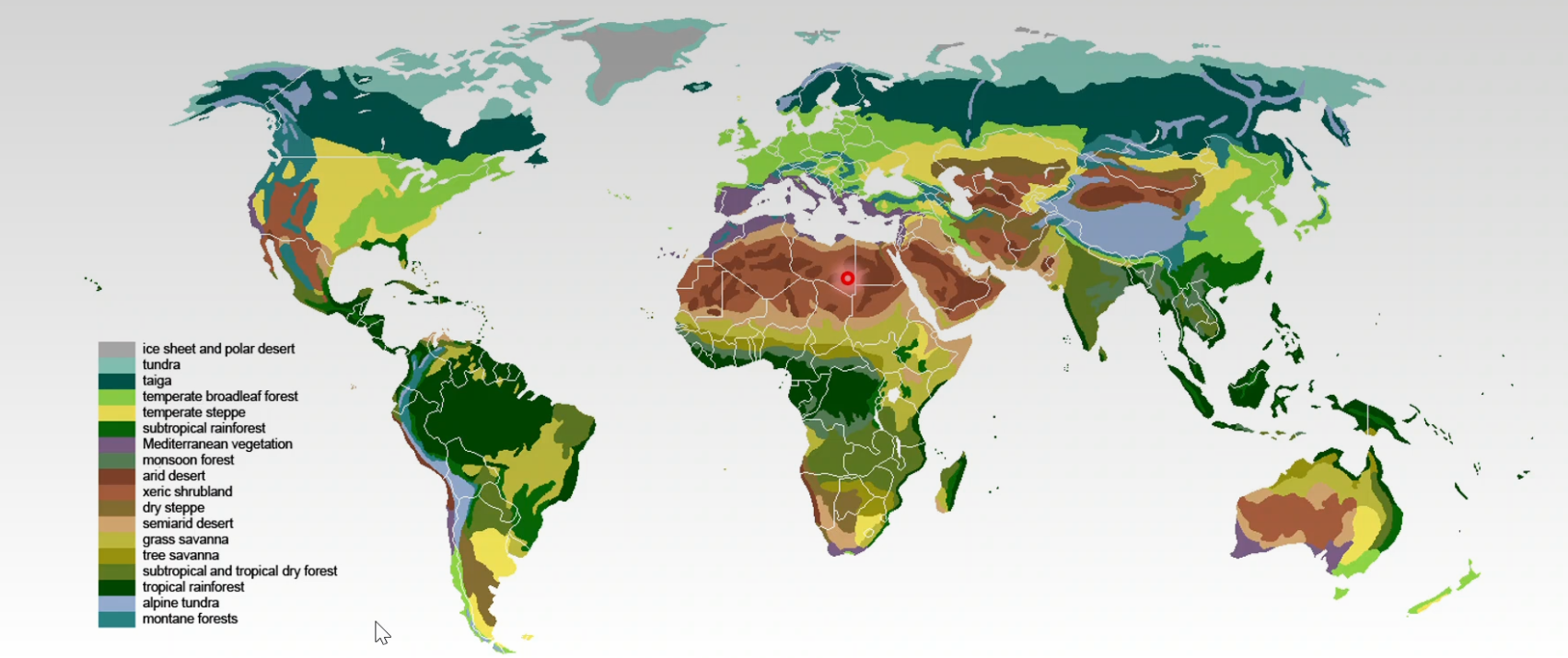- Prokaryotes
- Archaea and Bacteria
- Unicellular, lack a distinct nucleus
- Eukaryotes
- Eukarya
- have a nucleus and other distinctive structures in cells
- divided into 6 major groups and more subgroups
- Taxonomy - science of naming, describing, and classifying life
- Based on composition of and relationships between groups
- Phylogeny - describes evolutionary relationships between organisms
- Assumes plants and animals descended from common ancestors
- Evidence comes from fossil record, comparative anatomy and embryology, and molecular genetics
- Phylogenetic Tree
- Evolutionary relationships among groups of organisms through time
- Horizontal axis: anatomic differences
- Vertical axis: time

- Cladogram
- Relationships among members of a group (clade)
- Only depicts shared, derived traits among groups - no time axis
- Nested pattern of similarities

Archaea §
- single-celled organisms
- lack distinct cell nuclei
- relatively small
- includes both producers and consumers
- photosynthetic and chemosynthetic
- notable for ability toleration to extreme environmental conditions (extremophiles)
Bacteria §
- single celled organisms
- lack distinct nuclei
- also very small, diversity of shapes and sizes
- found in almost every environment on earth
- ancestors were some of the first life forms on earth
- cyanobacteria have at least a 3 billion year record, possibly 4 billion
Eukaryotes §
- cell or cells with DNA in a distinct nucleus
- complex structures
- microscopic to very large
- account for largest biomass on earth
- emerged about 2 billion years ago
- Split into Kingdoms
- Protists
- mostly unicellular, heterotrophic and autotrophic
- protozoans, dinoflagellates, diatoms, coccolithophores, foraminifera, radiolarians
- Plants
- multicelluar, autotrophic
- mosses, ferns, seed plants
- Fungi
- multicellular, saprophytic
- Animals
- multicellular, heterotrophic
- vertebrates and invertebrates
- insects, worms, sponges, fishes, mammals
Biomes §
- biological communities that form in response to physical environments (vegetation, soil, climate, wildlife)

Adaptations §
- Specialized features of animals and plants to perform useful functions
- Each organism has many of these to equip it for its way of life
- These stem from evolutionary heritage
- Evolution allows remodeling to serve functions, but have a common “ground plan”
- Suggests life has common origins because they share certain basic features
Evolution §
- living species have come into being because of the evolutionary transformation of earlier life forms
- Definitions
- Process by which living organisms have developed and diversified
- development of new organisms from pre existing ones
- change in the genetic composition of a population over generations
- Variation in species is result of selective pressures in different environments
George Cuvier (1760 - 1832) §
- “Father of Paleontology”
- believed earths history was punctuated by a series of catastrophes
- Different layers had different fossils
- Some disappear between layers
- Others appear
- Lowest layers had the most different fossils from modern life
- PROBLEM: Different fossils vanished at different layers
- Reconstructed past organisms based upon their bones (comparative anatomy)
- Basis for vertebrate paleontology
- Recognized that some fossils are extinct life
- A single flood is inadequate to explain the fossil record
- Used fossils to subdivide strata
- Only suggested as an application
Jean-Baptiste de Lamarck (1744-1829) §
- Lamarckian evolution has an end goal
- Traits acquired by individuals can be passed on to their offspring

- An early view of evolution that has changed
Darwin and the Galapagos §
- HMS Beagle
- 5 year journey
- Collected fossils
- Made observations
- Took Lyell’s Principles of Geology
- 14 finch species
- Postulated from single ancestor
- Beaks evolved due to food scarcity
- Species change through time
Natural Selection §
- Natural selection accounts for evolution
- Organisms possess inheritable variations
- Some variations more favorable than others in certain environments
- Individuals with more favorable variations are more likely to survive and reproduce and pass on their favorable variations
- Survival of the “fittest”
- Inheritable variations leading to differential reproductive success
- Changing environments cause selection of new characteristics and species
- Artificial selection
- Selective breeding
- practiced for thousands of years
- Humans are the selecting agent
- Choosing desirable traits and then breeding plants or animals with those traits
- Darwin was never able to explain the cause of variation within a population
Sources of Variation §
- Genetics - Gregor Mendel
- 1860’s experiments with garden peas
- Concluded that traits such as flower color are controlled by a pair of factors
- Genes - segments of DNA that encode for heritable traits
- Alleles = different versions of the same gene
- Sexual reproduction and mutations account for most variation in populations
- Mutations
- Imperfect copying -> random changes to genes (new allele)
- Changes in chromosomes or genes = changes in the hereditary information
- Chromosomal mutations
- Affect a large segment of the chromosome
- Point mutations affect a single gene
- May be harmful, beneficial, or have no effect
- Genetic drift
- Random change in a gene in a population is due to chance
- Affects small populations more than large\
Species and Speciation §
- Species
- Natural populations of similar individuals
- Can interbreed and produce fertile offspring
- Asexual organisms excluded in this definition
- Speciation
- Formation of a new species from ancestral ones
Micro and macroevolution §
- Micorevolution
- Evolutionary changes within a species
- Example: Organisms developing a resistance to insecticides
- Macroevolution
- Changes such as the origin of new species, genera, families, orders, and classes
- Example: amphibians evolving from fish
- Microevolutionary effects account for macroevolution
- Given sufficient time
- Isolation from genetic mixing in a large pool can accelerate evolution



